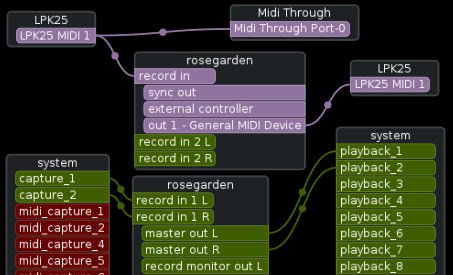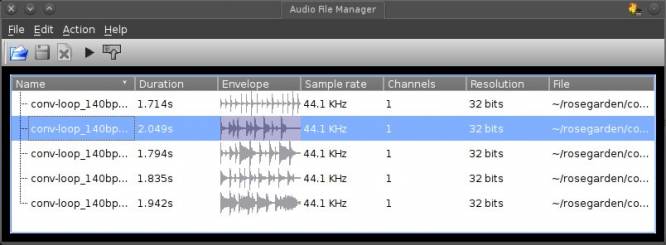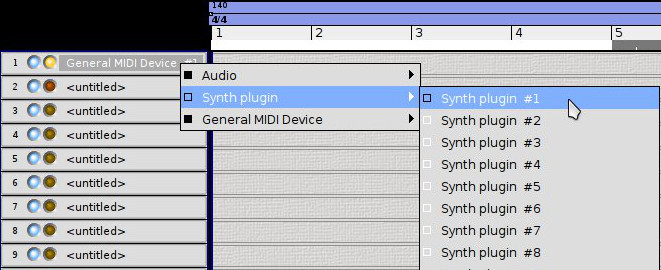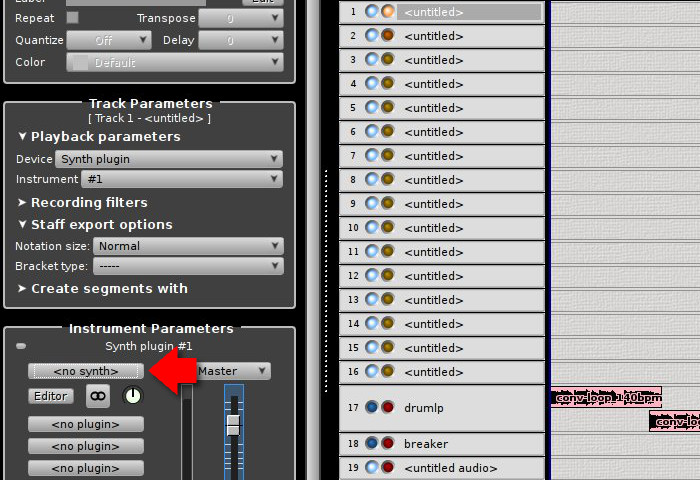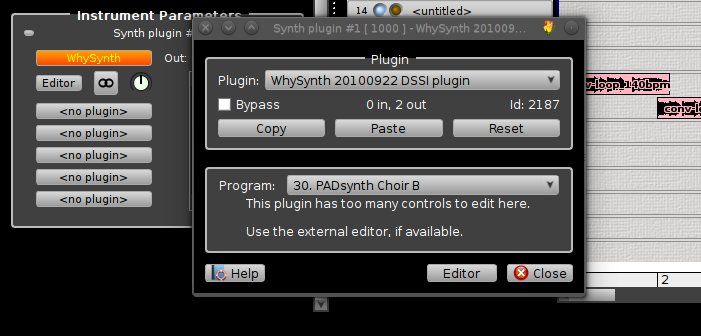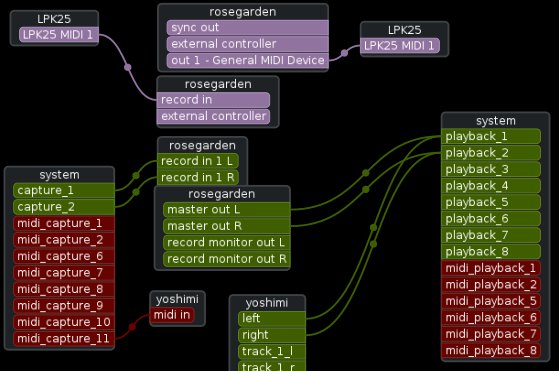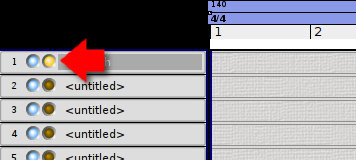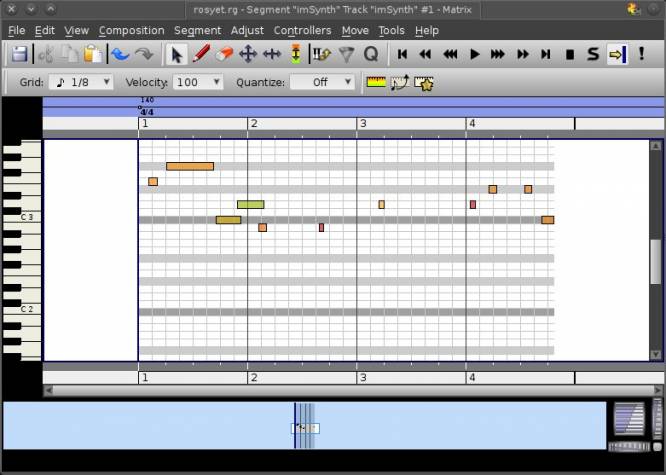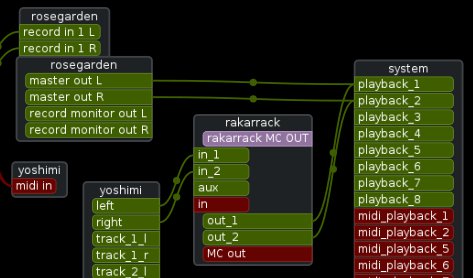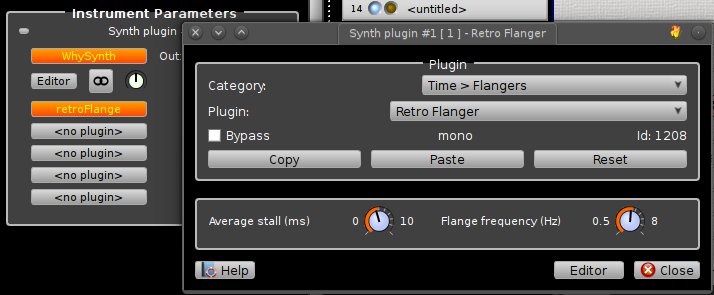Rosegarden
Rosegarden is a sequencer of everything audio-related. Rosegarden makes it easy for you to compose music using audio tracks, soft synths, MIDI, effects, and more.
Strengths [Weaknesses]
Full-Featured
Rosegarden knows exactly what it wants to be, and is focused and excellent at being a sequencer/DAW. It has no more and no fewer features than needed to be exactly that.
Efficient
A sensible user interface for fast and fluid control.
Intuitive
The Rosegarden user interface is designed so that common actions are contextually obvious. As long as you are somewhat familiar with the typical DAW paradigm, Rosegarden is easy and quick to learn.
Flexible
Rosegarden has access to internal soft synths, but also to any external synths and effects that JACK offers. It has an inbuilt mixer with audio routing (aux sends and returns), midi routing, sequencing, drum sequencing, and much more; you are free to build your own work environment, using whatever set of modular tools you prefer.
Weaknesses [Strengths]
Not a Waveform Editor
Rosegarden can import and mix audio, but if you are doing extensive work with recorded audio tracks (pop and click removal, for instance), then Rosegarden may not be the ideal tool for you.
All-Inclusive
Rosegarden is modular in the sense that it is fully JACK compliant, so it can accept sounds and signals from any other JACK client. However, if it is a truly modular, one-tool-per-function, experience then Rosegarden might be overkill for you.
Install
In order to compose music on a computer and have it play the music back as a complete musical work, you must use some kind of sequencer if only to get the different tracks to start at the same time. Rosegarden is a sequencer, with the ability to sequence MIDI events, route MIDI channels, place audio files, perform rudimentary mixing, apply effects, and more, making it a full fledged Digital Audio Workstation (DAW).
Usage
To use Rosegarden, you must run JACK, the audio subsystem that acts as a sort of patchbay for your system. Since not all applications send audio to JACK, JACK is used only on an as-needed basis. The order of launching your audio rig, therefore, is:
- Connect USB MIDI controller if you use one
- Launch jackd
- Launch Rosegarden
When Rosegarden first loads, it routes most of the important connections for you. The MIDI connections are:
- Your controller connects to the MIDI Thru of your MIDI system.
- Your controller also connects to the MIDI In of Rosegarden.
- The MIDI Out of Rosegarden connects to the MIDI In of your controller.
The audio connections:
- System capture connects to Rosegarden Record In
- Master Out of Rosegarden connects to System Playback
For greater control, go to the Edit menu → Preferences → Audio. Place a tick in the box next to Create JACK Outputs for individual audio instruments, and optionally for submasters. These will provide, upon future launches, a JACK output port for each track in Rosegarden so that you route each track as you please.
Audio
Rosegarden can handle imported audio files as well as MIDI data. To import an audio file:
- Select an audio track in the Rosegarden workspace. The audio tracks are preceded by a red light and are labelled as “Untitled Audio” in their track name field.
- Click on File → Manage Audio Files.
- In the Audio File Manager window, click the Add Audio File icon in the toolbar, or select File menu → Add Audio File.
- Choose audio files from your system.
- From the list of files you have added in the Audio File Manager window, select one and click the Insert into Selected Audio Track.
Give your new track a name by double-clicking on the track label, and typing a name into the text field.
Audio tracks can be edited as you would expect; splice the track with the Split tool from the top menu bar, erase clips with the Eraser tool, repair cuts with Join, and move clips around with the standard Arrow tool. All of these tools are available in a pop-menu that appears upon a right-click, or via keyboard shortcuts.
Rosegarden uses Audacity for in-depth waveform editing. To open an audio region in Audacity, right-click on the region and select Open in default editor from the contextual menu, or just press Return.
MIDI
Rosegarden is a full-featured DAW, so it has a plugin structure that allows you to use MIDI instruments and effects without leaving Rosegarden, but since Rosegarden is a JACK-aware application, there is the added flexibility of being able to use stand-alone synths and effects as well.
Plugins
The advantage to using plugins is that all routing information and synth settings are saved along with the DAW project itself. If you confine your music-making to plugins, you will never have to take snapshots of your JACK setup or save any session files other than that of the DAW itself.
To add a soft synth as a plugin to Rosegarden, right click on a MIDI track and set it to Synth Plugin → Synth Plugin #1. This points any MIDI data on that track to whatever plugin occupies the Synth Plugin #1 slot.
A MIDI track houses nothing but MIDI data. That's all it is; an in-application representation of a MIDI file. In order for your MIDI data (or spontaneous MIDI signals) to be of any use, you must have a destination for it.
To load a plugin in the Synth Plugin slot, select the MIDI track if it is not already selected, and click the no synth button in the Instrument Parameters panel on the left.
Choose a bank and patch for the synth in the plugin window that appears.
Try playing a few notes on your USB controller; you should hear the sounds over your speakers.
Stand-Alone Synth
The advantage to using stand-alone synths is that it keeps your studio modular, letting you swap out what DAW you use, what sequencer you use, every last detail of how things are routed, and so on. However, using tools external to Rosegarden means that you must take snapshots of your JACK setup and save all session files individually, as nothing outside of Rosegarden can be saved as Rosegarden settings.
A MIDI track houses nothing but MIDI data. That's all it is; an in-application representation of a MIDI file. In order for your MIDI data (or spontaneous MIDI signals, more likely) to be of any use, you must have a destination for it. In this example, use Yoshimi, which was installed as part of the Slackermedia queue file.
Launch Yoshimi from the K Menu or from a terminal. Yoshimi automatically creates a node in Patchage or a listing in QJackCtl.
Next, the MIDI track and the external synth plugin must be associated with one another; the MIDI data is useless if it's not directed at a listening MIDI port.
Part of this process happens within Rosegarden, and part is purely a JACK function.
Starting with the routing:
- Connect the Yoshimi Audio Out to System Playback.
- Connect a System Capture MIDI Capture port to Yoshimi. The number of the port may vary depending on your setup, and Rosegarden creates several MIDI ports for use as “General MIDI” outputs. A little trial and error might be called for, but start from the bottom and connect the final MIDI Capture to Yoshimi first. Try playing a few notes; if there is no sound, try a different port.
Once you have the appropriate MIDI signals routed to your synth, go back into Rosegarden.
Select the first MIDI track in Rosegarden (MIDI tracks have a yellow light next to them, and are labelled “untitled”). Right-click on the track label and verify that it is set to General MIDI → General MIDI Device 1. Ignore the “Acoustic Piano” label; it's a General MIDI label which does not apply to raw MIDI signals.
Recording MIDI
You don't need to connect the MIDI track to any synthesizer to record MIDI data (although it usually helps to hear what you are playing). You don't even need to record within Rosegarden itself. Since a MIDI track simply holds MIDI data, you can take existing MIDI files from either other sequencers or from MIDI repositories online and load them into Rosegarden, using them to drive your synths.
To record MIDI into the selected track, arm the MIDI track you want to record to by clicking the yellow Armed button on the far left of the track panel.
When ready, click the Record button in the transport window. Recording begins immediately and records each key press on your controller.
Manual Entry of MIDI
If you don't want to record anything, but want an empty region for manual entry, select the Pencil tool from the toolbar or press F3. With the pencil tool, click in the track and an empty region appears.
Editing MIDI
Once you have a MIDI region in a track, edit the MIDI data (or add more) in a “piano roll” editor; click on a MIDI region and press m on your keyboard, or click the Open in Matrix Editor icon in the toolbar.
Effects
Effects, like synths, can be external to Rosegarden or they can be plugins that occur within Rosegarden. If you use an external effect, just route the audio from a track through the effect, and then back into the System Playback.
To use plugin effects from within Rosegarden, select a MIDI or Audio track. In the Instrument Parameters panel on the left, click a no plugin button and choose an effect to load.
Exporting / Bouncing
Exporting your final project to a file (in audio terms, this is usually referred to as “bouncing”) requires a full, real-time playback of the selected area of your project and a recording application. The easiest recording application to use with JACK is aptly named Jack Capture.
By default, the “in” point of your playback region is the beginning of the project. Set an out point with the End Loop button in the transport window.
The marked region is highlighted as white in the top timecode bar.
To begin recording, click the record button on Jack Capture and Play in the Rosegarden transport window. Let the song play all the way through, and listen carefully for any trailing reverb or echo before stopping Jack Capture.
